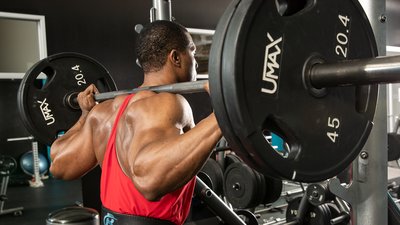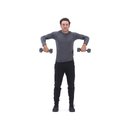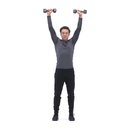Just about anyone can make progress following a chest program in the short term. The real trick is discovering a routine that works for more than few weeks. In the face of this challenge, lifters often train in "phases" where they are focused squarely on either strength or size. But I maintain you can build both chest size and bench strength at the same time, without having to go overboard with crazy volume or smashing the same muscle group multiple times a week.
In this program, you'll use science-backed principles of strength training to push your bench numbers and the tape measure at the same time. The best part about this approach? It has both progressive overload and a build-in deload, so you can start it again with a higher weight after four weeks. Don't be surprised if you keep making gains for months on end!
Start your workout with two sets of 10 reps of this shoulder-focused warm-up protocol.
Feeling that pump? Now you’re ready to do everything else.

BodyFit
$6.99/month- 2,500+ expert-created single workouts
- 3,500+ how-to exercise videos
- Detailed workout instruction
- Step-by-step workout tips
- Training at gym or at home
- Access to Workout Plans
- Access to Bodyfit App
- Store Discounts
Already have a Bodybuilding.com account with BodyFit? Sign In

What comes with BodyFit?

- Instructional Videos
Don't risk doing a workout improperly! Avoid injury and keep your form in check with in-depth instructional videos.

- How-to Images
View our enormous library of workout photos and see exactly how each exercise should be done before you give it a shot.

- Step-by-Step Instructions
Quickly read through our step-by-step directions to ensure you're doing each workout correctly the first time, every time.
You won't bench big without a solid warm-up
Before getting into the meat of the workout, warming up the muscles of the shoulder girdle is important to increase range of motion and minimize risk of injury.[1]
But it's not enough to just do some light-weight sets of benches. You also need to ensure that the smaller contributing muscles that stabilize the shoulder are firing properly. I shouldn't need to remind you that if you're injured, being on the sidelines won't do much for your bench.
For each of the three moves listed, there are only three rules. Number one, don't skip them. Number two, go light. And number three, don't take any of these sets anywhere close to muscle failure.
Technique keys: Barbell Bench Press
This is your big move on chest day, done first when you're strongest. You'll find people who say that the bench is better for strength than size, but I maintain that it's solid for both goals. A team of university researchers in Japan came to the same conclusion in 2014, observing a significant correlation between pectoralis major cross-sectional area (size) and bench press 1RM strength. The takeaway for you: If you want to get big, it's a good idea to get strong on this movement.[2]
The lower rep range you'll use here maximizes one of the mechanisms of hypertrophy known as "mechanical tension," which is thought to disrupt the structural integrity of skeletal muscle, causing molecular and cellular responses in muscle such as satellite-cell proliferation. This is believed to be a primary driver of muscle hypertrophy.[3]
Why the changes in load (intensity) and rep targets week to week? Research has shown that nonlinear periodization (also known as an "undulating" rep scheme) can lead to greater strength gains in trained athletes compared to those following a linear rep scheme.[4,5] Don't know how to determine percentages of your single-rep max? Use a calculator.
After completing one four-week training cycle, you can repeat the previous rep schemes, adding more weight than you were previously able to perform. This will ensure progressive overload, a fundamental factor in ensuring increased size and strength.[6]
It's important to note warm-up sets are not included. In addition, the first few sets will seem fairly easy, but avoid any extra reps past the stated rep target, even if you can do more. This will allow you to increase total training volume over time and keep building strength.
Incline Machine Press with Resistance Band
When pressing, working the pecs at different angles is an important variable if you're trying to overload different regions and build a well-developed chest. Researchers have found that the "clavicular fibers" of the chest (aka the "upper chest") have greater muscle activation on incline presses.[7]
On its own, the incline press follows an ascending strength curve; that is, it becomes easier the further you push. Utilizing a resistance band alters that strength curve, providing a novel stimulus that on its own can induce positive adaptations. Research has shown that using variable resistance—specifically, resistance bands—has increased 1RM strength performance and rate of power development.[8]
Once you reach failure, on your final set, remove the bands and extend the set until you can no longer perform a full repetition.
Weighted Dip
The weighted dip is a well-known chest builder, but what makes it great? Part of the dip's effectiveness stems from how your chest is built. While the fibers of the upper chest run largely horizontally, the fibers of the pec minor and lower fibers of pec major both run at more of a vertical or diagonal angle. In the case of a largely vertical movement like the dip, this arrangement helps direct the tension to those fibers.
This makes dips a particularly great exercise to target not only the lower region of the pecs, but also the anterior deltoid and triceps. If you improve the strength of all three of these muscles, your bench-press strength is almost certain to increase, as these are the primary movers.
Dips can overload the shoulder and triceps in their stretched position and increase muscle damage, which means greater potential hypertrophy. However, this also increases your risk of injury, which is why I recommend doing dips in a higher rep range, as well as stopping the set immediately once form and execution start to break down.
If the rep range of 15 is too low or too high for you, just add weight on a belt or take it away by using the assisted dip machine. Remember to kick your feet up behind your glutes to push your center of gravity forward so your body position is as horizontal as possible; this position best hits the pectoralis.
Doing all three presses at various angles with this amount of volume ignites muscle damage, which you accumulate over the course of the workout, another component that leads to hypertrophy.
Pec-Deck Fly
To ensure all fibers of the chest have been stressed, it's important to incorporate single-joint (aka isolation) work that takes your anterior delts and triceps largely out of the equation and force the chest to work harder. I prefer machine flyes over dumbbell flies, because the former provides tension throughout the range of motion, not just at the stretched portion
As you get to this part of your workout, the resultant cell swelling leads to an accumulation of metabolic stress, another mechanism of hypertrophy. So do your best to hit failure at 15 reps.
On your final set, once you reach failure, reduce the load by about 30 percent and continue on to a second point of muscle failure.
Incline Dumbbell Fly
In this final lightweight move, you'll overload the pecs in their fully stretched position and really inflict the necessary muscle damage to finish your workout. I recommend you externally rotate at your shoulders in the stretched position; that is, turning your palms to face toward the ceiling. As you reach the contracted position, internally rotate your shoulders (turning your palms to face each other).
Besides the change in angle from the previous movement, you'll also combine this with short rest intervals of just 30 seconds, to maximize metabolic stress. Your chest should be both fried and swole!
Given the large amount of muscle damage you'll be wreaking, once a week is plenty with this workout. Follow it to the letter, give it a chance to work, and then add some weight to your bench and do it all again!
References
- Woods, K., Bishop, P., & Jones, E. (2007). Warm-up and stretching in the prevention of muscular injury. Sports Medicine, 37(12), 1089-1099.
- Akagi, R., Tohdoh, Y., Hirayama, K., & Kobayashi, Y. (2014). Relationship of pectoralis major muscle size with bench press and bench throw performances. The Journal of Strength & Conditioning Research, 28(6), 1778-1782.Vandenburgh, H. H. (1987). Motion into mass: how does tension stimulate muscle growth?. Medicine and Science in Sports and Exercise, 19(5 Suppl), S142-9.
- Apel, J. M., Lacey, R. M., & Kell, R. T. (2011). A comparison of traditional and weekly undulating periodized strength training programs with total volume and intensity equated. The Journal of Strength & Conditioning Research, 25(3), 694-703.
- Zourdos, M. C., Jo, E., Khamoui, A. V., Lee, S. R., Park, B. S., Ormsbee, M. J., ... & Kim, J. S. (2016). Modified daily undulating periodization model produces greater performance than a traditional configuration in powerlifters. The Journal of Strength & Conditioning Research, 30(3), 784-791.
- Schoenfeld, B. J. (2010). The mechanisms of muscle hypertrophy and their application to resistance training. The Journal of Strength & Conditioning Research, 24(10), 2857-2872.
- Trebs, A. A., Brandenburg, J. P., & Pitney, W. A. (2010). An electromyography analysis of 3 muscles surrounding the shoulder joint during the performance of a chest press exercise at several angles. The Journal of Strength & Conditioning Research, 24(7), 1925-1930.
- Joy, J. M., Lowery, R. P., de Souza, E. O., & Wilson, J. M. (2016). Elastic bands as a component of periodized resistance training. The Journal of Strength & Conditioning Research, 30(8), 2100-2106.




